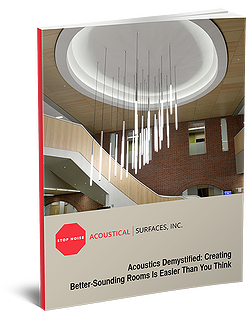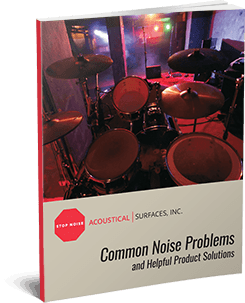Acoustical Solutions for Noisy Hair Salons and Spas
When clients step into a salon or spa, they expect more than just a haircut, massage, or facial–they expect an atmosphere of comfort and relaxation. Unfortunately, noise often gets in the way. Blow dryers, clippers, loud conversations, echoes bouncing off hard floors, and mechanical hums can turn what should be a soothing environment into an unnecessarily stressful one. This is where spa soundproofing and targeted acoustical design make all the difference.
Typical salons and spas are built with aesthetics and cleaning in mind: hard floors (wood, vinyl, or tile), drywall partitions, and hard ceilings made of drywall or corrugated metal. While hygienic, these materials reflect sound instead of absorbing it. The result is a lively, sometimes chaotic soundscape where every dryer blast or phone call seems amplified. Without intervention, poor acoustics can disrupt relaxation, reduce staff focus, and even lead to noise complaints from neighbors.
In this article, we’ll explore the most common noise challenges in salons and spas, highlight the areas where acoustical control matters most, and share professional acoustic solutions for spas that create a calm, productive, and enjoyable atmosphere.
5 Key Areas Where Salons and Spas Need Sound Control
Different zones in a salon or spa come with unique acoustical challenges. Addressing each space properly is key to achieving a balanced, quiet spa environment.
1. Reception Area
The first impression of any business comes at the front desk. Unfortunately, reception areas can be particularly problematic and loud. . Clients talking on phones, music in the background, and conversations from the styling floor all mix together here. With hard flooring and reflective walls, ambient noise quickly builds up.
Without echo reduction, the reception area feels busy and overwhelming instead of calm and welcoming.
2. Main Styling Floor
This is the heart of any salon–and also the noisiest. Blow dryers, clippers, and conversations all contribute to sound levels that can exceed 85 decibels, equivalent to heavy street traffic. In an open floor plan with tile or glass, the sound reflects and multiplies.
Without proper acoustic treatment, clients may struggle to converse with stylists and staff can feel fatigue from constant noise exposure.
3. Shampoo and Wash Stations
Running water, rinsing bowls, and voices carry easily in shampoo areas and wash stations. Tile walls, mirrors, and porcelain sinks create a reflective, acoustically harsh environment.
Without soft finishes, this space can become one of the main contributors to overall noise pollution in the salon.
4. Private Rooms in Spas or Massage Rooms
These spaces demand tranquility–but thin walls and hollow-core unsealed doors often allow sound leakage. It’s also extremely common for these rooms to have drop ceilings and shared air space above the ceiling tiles. This plenum area, combined with shared HVAC ductwork, provides an easy pathway for sound to travel from room to room. Conversations, hairdryer noise, or even HVAC vibration can intrude on what should be a relaxing and private space.
Privacy is critical here, and acoustic wall treatments or soundproofing solutions like upgraded doors, heavy noise barrier ceiling tile backers and duct treatments are often essential to maintaining a truly quiet spa environment.
5. HVAC and Mechanical Rooms
Many spas and salons struggle with the low-frequency hum and vibration of mechanical equipment. HVAC systems, laundry machines, and water heaters create structural vibrations and airborne noise that travel through walls and ceilings.
Without appropriate sound dampening for commercial spaces, even a massage room far from the equipment may experience unwanted background noise.
Best Acoustical Treatments for Hair Salons and Spas
Every salon or spa is different, but common problems can be solved with a suite of customized acoustic treatments for spas. Acoustical Surfaces offers proven solutions that balance aesthetics with performance.
Decorative Acoustical Wall Panels
Perfect for styling floors, reception, and shampoo areas, fabric wall panels absorb sound reflections and dramatically reduce echo. Unlike plain foam, these panels are designed to be both attractive and functional, blending seamlessly into upscale décor. Options like Fabric-Wrapped Fiberglass panels or Poly Max™ panels provide high sound absorption while complementing interior design. If you’re on a tight budget, the Echo Eliminator™ panels are an excellent way to add a significant amount of absorption to a room without breaking the bank. By reducing reverberation, they enhance voice clarity and create a more pleasant environment for clients and staff. All of these options are going to last a lot longer if they are placed in areas where they will be away from contact or water splashing on them.
Acoustical Hanging Banners or Clouds
In salons with tall ceilings, acoustic ceiling tiles or suspended hanging clouds or beautiful, wave-shaped acoustical banners can add another layer of sound absorption. While low ceilings with fire sprinklers often limit options, suspended ceiling treatments can be highly effective in large, open spaces.
They help reduce overall reverberation and control ambient noise on busy styling floors.
Door and Wall Soundproofing for Treatment Rooms
Spa rooms require privacy. Upgrading walls with Green Glue and an additional layer of drywall helps to reduce noise transfer between rooms with shared walls. For doors, specialized acoustic door bottoms and adjustable jamb seal gaskets prevent sound leaks around edges. Together, these treatments help ensure a peaceful client experience.
Read More: How Does Green Glue Compound Work?
Floor Sound Dampening
For salons located above other businesses, or in multi-story spaces, vibration transfer through floors can be a serious issue. Products like Acoustik™ recycled rubber underlay will reduce impact noise from foot traffic and equipment vibration, protecting neighboring tenants from unwanted noise.
While this doesn’t address in-room acoustics, it’s an important part of beauty salon soundproofing.
Salon Layout Tips to Minimize Noise Without Construction
Not every salon or spa can undergo major renovations. Some property owners won’t allow them, and some salon owners can’t afford to lose business during prolonged projects. Fortunately, there are practical design and layout strategies that reduce noise without construction.
- Separate loud and quiet zones: Position blow-dry and shampoo stations away from massage or facial rooms.
- Decor as acoustical tools: Curtains, upholstered furniture, and fabric wall art absorb a small amount of reflections to subtly soften overall noise.
- Bookshelves and partitions: Strategic placement of furniture or shelving units adds sound absorption and creates visual separation.
- Room planning: Build enclosed service rooms with properly treated HVAC ducts for noisy equipment, rather than relying on partitions that leave shared airspace.
These small changes won’t eliminate noise, but they do contribute to a calmer, more controlled atmosphere.
Frequently Asked Questions About Salon and Spa Acoustics
Can I soundproof a spa room without remodeling?
Somewhat, but it really depends on the room. While true soundproofing almost always includes some level of construction, it is possible to dramatically reduce the amount of sound transfer without remodeling. You can mount surface acoustic panels in rooms that have too much echo and reverberation to reduce strength of the sound in the specific room. Upgrade to solid-core doors and add adjustable door seal kits to seal the perimeter of the door. You can also add noise barrier ceiling tiles or back standard ceiling tiles with regular drywall to reduce the amount of sound going over a common wall. This combination is often enough to create a noticeably quieter spa environment.
Do acoustic panels help in salons?
Absolutely. Acoustic panels are one of the most effective acoustic wall treatments for reducing echo from blow dryers, conversations, clippers and anything else going on in the space.
Is soundproof flooring worth it?
If your salon is located above another tenant, yes – If you can do some construction to the room. Floor underlayment reduces impact transfer and vibration, protecting the neighbors below. Floor soundproofing products go under the finish floor and are construction grade materials.
How much does salon soundproofing cost?
Costs vary depending on the scope, as well as what you can or can’t do to the space. Many salons start with budget-friendly wall panels and later invest in full systems with upgraded walls, doors, and ceiling treatments.
Real-World Salon Noise Problem: A Case from Our Blog
A salon owner who moved into a new space quickly discovered how disruptive acoustics could be. The shop had hardwood floors, plaster-over-block walls, and drywall ceilings–hard, reflective surfaces everywhere. Even before opening day, the echo was overwhelming, but once customers and staff filled the space, the problem multiplied. Blow dryers, clippers, and conversations all bounced around the room until the noise was nearly unbearable. Clients struggled to hear their stylists, stylists had to raise their voices, and the overall environment felt chaotic. The owner described the opening day as “bedlam.”
Looking for a solution that was cost-effective, attractive, and didn’t interfere with the salon’s design, the owner turned to Acoustical Surfaces and spoke with one of our senior advisors. After exploring a variety of options, they installed Echo Eliminator™ Panels on the 10-foot ceiling, carefully arranged around lights, vents, and speakers. Even with partial coverage–only about 60 square feet of panels–the results were immediate. Echo disappeared, conversations became clear, and hairdryer noise no longer dominated the space.
The staff and clients noticed the difference right away. The panels not only solved the noise control issue but also blended seamlessly with the ceiling, adding subtle texture without distracting from the décor. The benefits were substantial enough that the salon owner added more panels near the reception area to completely eliminate the remaining echo. This case demonstrates how a well-planned application of acoustic panels can dramatically improve comfort, communication, and atmosphere in a busy beauty environment.
Final Thoughts: A Quieter Space is a Better Experience
Noise is inevitable in a busy salon or spa–but chaos isn’t. By combining beauty salon soundproofing strategies with targeted acoustical products, owners can transform loud, echo-filled spaces into havens of relaxation. From controlling blow dryer reverberation to creating privacy in treatment rooms, professional acoustic solutions for spas enhance both client satisfaction and staff well-being.
Whether you’re a small salon battling noise complaints or a high-end spa looking to refine the guest experience, acoustical improvements are an investment in your brand’s success. Contact one of our experienced team members today to learn more about spa soundproofing and acoustic design, and find the right solutions for your unique space.









2 Comments
Dana Downs
Does insulation on the back of canvases work? Need some sound/echo absorption.
Ted W
Dana,
Thank you for the comment! The answer to your question is going to be variable and really depend on the canvas and what has been applied to it.
Canvas, naturally speaking, is not a very good fabric to use in front of acoustical panels because it is relatively dense and not very porous. Further, if the canvas has been painted with quite a few layers of paint and all of the holes and gaps in the canvas have been completely clogged and covered.
It is imprtant to keep in mind that sound travels through air, and if air can flow through the canvas, so can the sound – and the idea is to get the sound to the absorptive material on the back side.
When we wrap panels or provide stretch-fabric systems, we use fabric that is very porous. So much so that you can breathe through the fabric quite easily. I often suggest to people to hold the fabric up to the light and determine how much light can pass through the fabric. For instance, burlap would be a GREAT fabric to use, where as denim would be not nearly as good.
I hope this helps.
thank you,
Ted